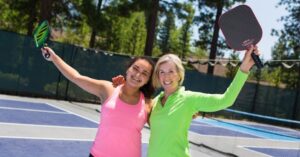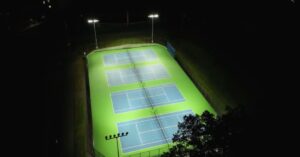Pickleball beginners are often intrigued by the sport’s unique terminology, and one term that sparks curiosity is “the kitchen.” Despite its household name, the kitchen in pickleball holds no similarities with the kitchens in our homes. The pickleball kitchen rules have significant importance in shaping the game’s dynamics. As players engage in fast-paced rallies and strategic maneuvers on the court, understanding the origin and purpose of the kitchen adds a nuanced layer to the sport.
Why is it called the kitchen in pickleball? There are several theories in the pickleball community, but a definite answer still needs to be answered. It’s just one of those questions you speculate and drive your conclusions from.
Today, we explore the kitchen of a pickleball court, briefly discuss its history, comment on the terminology, and understand its role and significance. Whether you’re a seasoned player or a court newcomer, the kitchen’s intriguing nomenclature will enhance your curiosity about the game. Through this exercise, you’ll appreciate the inventive charm of the pickleball makers who made it a sport like no other.
Pickleball Kitchen Rules
The kitchen of a pickleball court is also known as the non-volley zone. A rectangular area on either side of the net limits players from executing volleys within the zone. Volley in paddle sports is hitting the ball without letting it bounce. Volleying in the non-volley zone is a fault according to the pickleball kitchen rules.
This rule is significant to keep players from continuously hitting powerful shots close to the net. In making a non-volley kitchen in pickleball, the makers have strategically increased the gameplay’s nuance, encouraged a diverse skill set rather than just power shots, and maintained fair play.

Why Is It Called the Kitchen
While the origin of the term “kitchen” for the non-volley zone in pickleball remains elusive, theories suggest a blend of the founders’ lighthearted spirit and possible inspiration from the shuffleboard’s scoring zones.
The first theory is that the sport’s founders, three family men renowned for their playful spirit, found the household term for the court amusing, embodying the lighthearted essence of pickleball’s origin. However, it’s unclear what it was in the kitchen rules of pickleball that reminded them of the term.
The second theory ventures into shuffleboard, a cues and discs game. It proposes that the pickleball kitchen borrowed its name from the “10-off” area in the shuffleboard, where landing a disc is prohibited and results in a point deduction.
Whether a nod to the founders’ humor or an homage to another game’s scoring zone, the kitchen in pickleball remains an enigmatic yet charming aspect of the sport, adding a touch of playful mystery to the court.
Pickleball Kitchen Size
The pickleball kitchen stretches 7 feet in length and 22 feet in width (runs parallel to the width of the court’s baseline) on each net side. This is the area where volleying is prohibited. The presence of a non-volley court dictates a rhythm of the game that fosters a balance between power, skill, and precision.
The pickleball kitchen’s size is small compared to the serving zones, yet its presence emphasizes the need for calculated moves and quick thinking, which adds more dimensions to the game.
How Big Is the Kitchen In Pickleball
The kitchen extends 7 feet in length on both sides of the net, restricting players on both sides from volleying near the net. We detail the kitchen rules below to explain how a non-volley zone’s presence complicates the nature of the play.
Kitchen Rules in Pickleball
The essence of the kitchen rules in pickleball lies in the prohibition of volleys within the designated area. A volley, defined as striking the ball before it bounces, becomes a forbidden art within these confines. Players cannot execute volleys while standing within the NVZ or outside while extending their paddle, which challenges their agility and shot selection.
Volleying within the kitchen isn’t just a breach of rules; it results in a fault. A fault disrupts the flow of a rally (back-and-forth hits between the two teams), giving an advantage to the opposing team and emphasizing the strategic significance of abiding by kitchen rules.
The kitchen rules in pickleball fundamentally alter how players approach the net. Mastery of the non-valley play is essential to succeed against high-level players. A kitchen on the pickleball court influences a player’s shot selection, footwork, and overall gameplay strategy.
Players must be careful while skillfully balancing offensive and defensive maneuvers. The consequences are the same: a slight toe invasion or a delayed shot. They either give a point or an advantage to the opponent. Volleying in the kitchen costs points and disrupts the fluidity of rallies, pushing players to refine their court awareness and strategic finesse.
The kitchen rules of pickleball demand precision and adaptability alongside a deep understanding of the court dynamics. This is where the player shows their finesse with the paddle rather than their superior speed or strength.
Pickleball Kitchen Playing Guide
As players step onto the pickleball court, mastering the art of navigating the kitchen becomes a crucial aspect of their gameplay. One of the striking indicators of a high-level player is their strategic use of footwork and positioning within the non-volley zone.

Toeing The Line
To gain an upper hand, players often employ a tactic known as “toeing the line.” As the idiom that inspires the tactic suggests, they go as near to the non-volley zone as the pickleball kitchen rules allow to volley the ball without touching it themselves or being in contact with anything that does. This will enable them to make quick transitions between offensive and defensive maneuvers.
The Dink
A dink shot in pickleball is an intermediate to advanced move where players gently tap the ball over the net, keeping it low and close to the opponent’s side. The ball naturally lands in the kitchen, the closest region of the opponent’s court.
Advanced players execute dinks precisely, using a soft touch on the paddle to control the trajectory. The goal is to force opponents into a problematic position near the non-volley zone, setting up strategic opportunities for subsequent shots.
The Dink and Lob Strategy
One of the nuanced strategies within the kitchen involves the dink and subsequent lob. A soft, controlled, well-executed dink lures opponents to the kitchen to receive the ball before it bounces. This sets the stage for a perfectly timed lob.
The lob is a power shot that sends the ball far into the opponent’s court at a height that forces them to quickly maneuver from the non-volley zone to near the baseline to make the shot.
The dink and lob strategy is legal under kitchen pickleball rules as it doesn’t involve volleying in the non-volley area. It demands the opponent to make swift movements and even more speedy decisions. While volleys are prohibited in this zone, players can perform various groundstrokes, including dinks and lobs.
The key to perfecting a dink and lob sequence is learning to adapt to the circumstances of the match as they change, anticipate the opponent’s strategy and thinking, and keep practicing both offensive and defensive postures. Drills also prove helpful in building your muscle memory as you start using the technique in matches.
The dink and lob sequence is a well-rounded approach to playing in the kitchen. It reminds us that keeping up with the game’s dynamics is not limited to athletic prowess but requires players to do mental gymnastics to get in their opponent’s head and anticipate their moves. It requires them to make split-second decisions, and the distinction between fault and fair play according to pickleball kitchen rules often hinges on this acute awareness.
Can You Land in The Kitchen in Pickleball
In pickleball, landing in the kitchen can result in a fault, which either gives a point to your opponent if they’re serving or gives them an advantage if you’re serving. You can only hit the volley shot outside the non-volley zone.
When executing a volley shot, landing in the kitchen during the act is considered a fault, emphasizing the importance of avoiding this restricted zone while playing at the net. There are specific scenarios, however, where it’s allowed.
The kitchen rules in pickleball permit players to jump and land in the kitchen as long as they’re not actively volleying. A skilled move called the “erne” also allows players to jump and volley the ball mid-air over the kitchen. The condition is they start and finish the jump outside this area.
Common Permissions
Players are allowed to engage in groundstrokes, i.e., hit the ball after it has bounced. This is particularly relevant when returning a dink shot that lands the ball in the opponent’s kitchen. The distinction between volleys and groundstrokes is crucial in determining if a kitchen rule has been violated.
A common misconception among beginners is the fear of contact near the kitchen area. It’s important to note that the space above the non-volley zone is not included in the pickleball kitchen rules. Consequently, players can extend their paddles over the kitchen line during a volley as long as the rest of their body remains behind the non-volley zone line. This is the “Erne” shot.
In essence, the rules surrounding the kitchen aim to prevent overly aggressive play at the net, ensuring fair and strategic gameplay in the spirit of pickleball’s inclusive nature. Players who master the permissible actions within the non-volley zone gain a competitive edge in this dynamic racquet sport.
Common Faults
Firstly, players can enter the kitchen at any point during a game. However, they must adhere to the fundamental rule: no volleys are permitted within the zone.
In pickleball terminology, a volley refers to striking the ball out of the air before it bounces. According to the pickleball kitchen rules, players can only enter the kitchen for brief periods when the ball has bounced, ensuring that volleys are executed legally.
The kitchen line, often colloquially referred to as the “no-volley line,” runs from sideline to sideline, defining the extent of this zone. Players must be mindful not to touch any part of the kitchen during the execution of a volley shot. This differs from the “erne” described before, a legal move on the court.
The non-volley zone has specific rules dictating what actions are permissible. Understanding these rules is crucial for players aiming to master the strategic use of the kitchen.

FAQs
The kitchen of a pickleball court often confuses novice players. Here are a few commonly asked questions regarding the kitchen that may help you.
A kitchen violation in pickleball occurs when a player violates pickleball’s kitchen rules. If a player makes contact with the ball in the air while standing inside the kitchen or any part of their body, paddle, or clothing touches the kitchen while volleying, it results in a kitchen violation.
The rule is set to encourage the players to incorporate different shots into their gameplay and add more dimensions to their strategy.
Can you touch the kitchen before a bounce?
No, stepping into the kitchen before the ball bounces is not allowed in pickleball. The non-volley zone, or the kitchen, is designated where volleying (hitting the ball before it bounces) is strictly prohibited. If you step into the kitchen before the ball bounces, it is with the intent to volley. This results in a violation of the kitchen pickleball rules.
In pickleball, you can step into the kitchen after the ball bounces. The rules dictate that players must wait until the ball makes contact with the court surface before entering the kitchen and attempting a volley shot. Touching the kitchen before a bounce is a violation, and players need to time their movements strategically to adhere to this rule.
No, in pickleball, the serve must never land in the kitchen. The server must clear the kitchen line to be considered valid. The only permissible part of the court to land a serve in is the diagonally opposite serving court to the server. If you start from your right serving court, you must land the ball in the opponent’s right serving court (your left). Failure to do this results in a fault.
Players must not volley while touching the kitchen. This restriction applies to the player’s contact with the kitchen through any part of the body, paddle, or clothing. The rules aim to prevent players from dominating the net with aggressive smashes, fostering fair and strategic gameplay. Volleying in the zone is a fault in the pickleball kitchen rules.
The five golden rules of the kitchen in pickleball are as follows:
- The player must not stand in the kitchen during a volley
- The player must be careful with the kitchen lines, ensuring no part of the body or equipment touches these boundaries during regular shots.
- The player must not land a serve in the kitchen zone.
The Pickleball Kitchen: A Cleverly Plotted Zone
The non-volley zones and the kitchen line serve as a reminder of pickleball’s dynamic gameplay. The pickleball kitchen size occupies about a quarter of the court in length. Yet its presence changes the game entirely.
The zone is one of the significant distinctions between a pickleball and a tennis court. Volleying is not allowed on the tennis court at all neither is there a kitchen on the tennis court. This makes pickleball’s kitchen a unique and clever invention, the credit that goes to its inventors.
How do you feel about the kitchen? Are you satisfied with your dink and lob technique? We’d love to hear your thoughts below.











